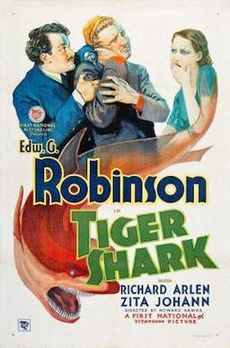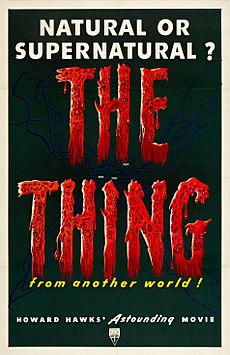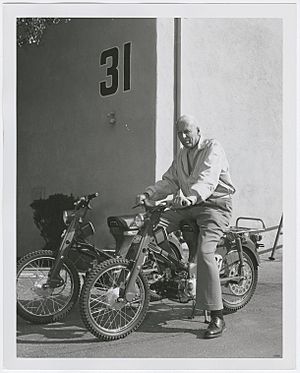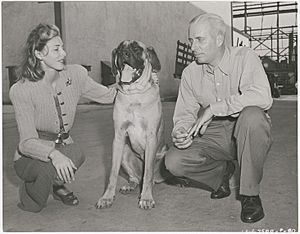Howard Hawks facts for kids
Quick facts for kids
Howard Hawks
|
|
|---|---|

Hawks in the 1940s
|
|
| Born |
Howard Winchester Hawks
May 30, 1896 Goshen, Indiana, U.S.
|
| Died | December 26, 1977 (aged 81) Palm Springs, California, U.S.
|
| Alma mater | Cornell University |
| Occupation |
|
| Years active | 1916–1970 |
|
Notable work
|
Scarface, Bringing Up Baby, Only Angels Have Wings, His Girl Friday, Ball of Fire, To Have and Have Not, The Big Sleep, Red River, Gentlemen Prefer Blondes, Rio Bravo
|
| Spouse(s) |
Athole Shearer
(m. 1928; div. 1940)Slim Keith
(m. 1941; div. 1949) |
| Children | 3, including Kitty Hawks |
| Relatives |
|
Howard Winchester Hawks (born May 30, 1896 – died December 26, 1977) was a famous American film director, producer, and writer. He worked during the "Golden Age" of Hollywood. Many film experts, like Leonard Maltin, called him one of the greatest American directors. He was known for making movies that felt very real and natural.
Hawks was a very flexible director. He made movies in many different styles, like comedies, dramas, gangster films, and Westerns. Some of his most popular films include Scarface (1932), Bringing Up Baby (1938), His Girl Friday (1940), and Rio Bravo (1959). He often showed strong, confident female characters in his films. These characters became known as the "Hawksian woman".
Even though he made many great movies, Hawks was only nominated once for an Academy Award for Best Director. This was for his film Sergeant York (1941). However, in 1974, he received a special Honorary Academy Award. This award recognized him as "a giant of the American cinema". His movies have inspired many well-known directors today, like Martin Scorsese and Quentin Tarantino.
Early Life and First Steps
Howard Winchester Hawks was born in Goshen, Indiana. His father was a successful paper manufacturer, and his mother's father was also a wealthy businessman. Howard was the oldest of five children. His family moved around a bit, living in Neenah, Wisconsin, and later settling in Pasadena, California.
As a kid, Hawks wasn't known for being a great student or athlete. But he loved coaster racing (an early form of soapbox racing). He also became very skilled at tennis, even winning the United States Junior Tennis Championship when he was 18.
In 1914, Hawks went to Cornell University to study mechanical engineering. He was a big reader of popular novels. During his summer break in 1916, he got his first taste of the film industry. When the United States joined World War I in 1917, Hawks left college to join the Army. He became a lieutenant in the Aviation Section, U.S. Signal Corps. He taught other pilots how to fly. These experiences later helped him make aviation films, like The Dawn Patrol (1930).
Starting a Film Career (1916–1929)
Hawks's love for aviation led him to meet important people in Hollywood. In 1916, he met Victor Fleming, a cinematographer who was also an early pilot. Hawks had a race car and met Fleming when they crashed on a dirt track. This meeting helped Hawks get his first job in movies as a prop boy for the film In Again, Out Again. He quickly showed he was good at building sets and helping out.
Hawks started directing films when he was just 21. He worked with famous actress Mary Pickford. He even directed a scene for her when the main director didn't show up. After serving in the Army during World War I, Hawks was eager to return to Hollywood. He and his brother, Kenneth, moved there together.
Hawks used his family's connections to get a job overseeing short comedies for Jack L. Warner, a studio head. Hawks said he directed some of these shorts himself. Later, he formed his own production company called Associated Producers. This company made 14 films, but Hawks soon realized he wanted to direct full-time, not just produce.
In 1923, Hawks became a story editor at Famous Players-Lasky (which later became Paramount Pictures). He was in charge of many film projects and helped write scripts. He worked on films like Tiger Love. He then moved to Metro-Goldwyn-Mayer (MGM) with the promise of becoming a director. When that didn't happen quickly enough, he left.
In 1925, Sol Wurtzel at Fox Film Corporation offered Hawks a directing job. Over the next three years, Hawks directed his first eight films. Six of these were silent films, and two had sound. He often rewrote scripts without getting official credit. His first film was The Road to Glory (1926). His first hit as a director was Fig Leaves (1926), a comedy.
One of his most important silent films was A Girl in Every Port. This movie showed many of the themes Hawks would use later, like the strong bond between two men. It was also his first film about aviation, The Air Circus (1928). This film was made during a time when aviation was very popular. Hawks's contract with Fox ended in 1929. After this, he chose to work as an independent director, meaning he didn't sign long-term contracts with one studio. This gave him more creative freedom.
The Rise of Sound Films (1930–1934)
When "talkies" (movies with sound) became popular around 1930, it changed Hollywood a lot. Hawks, who had already directed many successful silent films, had to prove himself again.
His first full-sound film was The Dawn Patrol. It was a war film about aviation. Hawks hired many experts who had worked on Howard Hughes's big aviation movie, Hell's Angels. Hughes tried to stop Hawks's film, but they later became good friends. The Dawn Patrol was a huge hit in 1930. Its success helped Hawks become a respected director who could work independently.
Hawks then directed The Criminal Code (1931) for Columbia Pictures. It was a hit but was banned in Chicago due to its content. Next, Howard Hughes hired Hawks to direct Scarface, a gangster film based on the life of Al Capone. This movie faced many problems with film censors (people who decided what could be shown in movies). Hawks and Hughes fought for over a year to get it released. Scarface was also the first time Hawks worked with writer Ben Hecht, who became a close friend.
After Scarface, Hawks made The Crowd Roars, a film about car racing, which was one of his childhood interests. He even used real race car drivers in the movie. It was another hit.
In 1932, he directed Tiger Shark starring Edward G. Robinson. In these early films, Hawks started to show his typical "Hawksian Man" character: a tough, professional man who is good at his job. Hawks also showed his skill at adding humor to serious stories. He then made three films at MGM, but he left before finishing two of them because of studio interference.
Famous Films and Later Career (1935–1970)
In 1934, Hawks made his first "screwball comedy" called Twentieth Century. It starred John Barrymore and Hawks's distant cousin Carole Lombard. This film helped define the screwball comedy style, which is known for its fast-paced, witty dialogue and funny situations.
He continued to make successful films, including Barbary Coast (1935) and the aviation adventure Ceiling Zero (1936). However, he was fired from Come and Get It (1936) by the producer Samuel Goldwyn.
In 1938, Hawks directed the classic screwball comedy Bringing Up Baby for RKO Pictures. It starred Cary Grant and Katharine Hepburn. The movie is famous for its wild humor and the great chemistry between the two stars. Even though it was a box office failure at first, it is now considered one of Hawks's best films. After this, Hawks had 11 successful films in a row.
In 1940, he made another screwball comedy, His Girl Friday, with Cary Grant and Rosalind Russell. This film is known for its incredibly fast dialogue. In 1941, Hawks directed Sergeant York, starring Gary Cooper. This film was a huge success and was the highest-grossing film of 1941. He also worked with Cooper and Barbara Stanwyck in Ball of Fire (1941), a funny take on the Snow White story.
During World War II, Hawks made the film Air Force (1943). Then, he directed two famous films with real-life couple Humphrey Bogart and Lauren Bacall. These were To Have and Have Not (1944) and The Big Sleep (1946). Bogart and Bacall fell in love while making To Have and Have Not.
In 1948, Hawks directed the epic Western Red River, starring John Wayne and Montgomery Clift. He also remade his earlier film Ball of Fire as A Song Is Born, which featured famous jazz musicians like Louis Armstrong.
In 1951, Hawks produced, and many believe also directed, the science-fiction film The Thing from Another World. Director John Carpenter said it was "pure Hawksian" because of the strong bond between the male characters. He continued to make Westerns like The Big Sky (1952). He also worked with Cary Grant for the last time in the comedy Monkey Business, which also starred Marilyn Monroe.
In 1953, Hawks directed Gentlemen Prefer Blondes, famous for Marilyn Monroe singing "Diamonds Are a Girl's Best Friend." This film starred Monroe and Jane Russell as two best friends. In 1959, Hawks made another classic Western, Rio Bravo, starring John Wayne, Dean Martin, and Ricky Nelson. This film is highly praised by many film critics.
Hawks continued to work with John Wayne in films like Hatari! (1962), about catching wild animals in Africa. His last comedy was Man's Favorite Sport? (1964). He returned to his love for car racing with Red Line 7000 (1965). Hawks's final two films were Western remakes of Rio Bravo, both starring John Wayne: El Dorado (1966) and Rio Lobo (1970).
Final Years
In his later years, Hawks's health began to decline. He passed away on December 26, 1977, at the age of 81. His death was caused by complications from a fall at his home in Palm Springs, California.
Personal Life
Howard Hawks was married three times. He had two children with his first wife, Athole Shearer, and one daughter, Kitty Hawks, with his second wife, Slim Keith. He also had a son, Gregg, with his last wife, Dee Hartford.
Besides filmmaking, Hawks loved cars and motorcycles. He even built a race car that won the Indianapolis 500 race in 1936. He also enjoyed riding motorcycles and continued to do so until he was 78 years old. His other hobbies included golf, tennis, sailing, and horse racing.
Hawks was good friends with many famous American writers, like Ben Hecht, Ernest Hemingway, and William Faulkner. He is even credited with discovering William Faulkner and helping him get started in Hollywood. Faulkner wrote five screenplays for Hawks. Hawks and Hemingway shared interests in fishing and skiing.
Directing Style
Hawks was known for being a very flexible director. He made movies in many different genres, including comedies, dramas, gangster films, science fiction, and Westerns. He had a simple idea of what made a good movie: "Three great scenes, no bad ones." He also believed a good director "doesn't annoy you."
His directing style focused on making films enjoyable and straightforward. He often let his actors be natural and didn't do too many takes. This helped keep the humor and realism in his comedies.
Hawks also became known for the "Hawksian woman". These were strong, independent female characters, which was quite new for movies in the 1920s. Another common theme in his work was showing how people interact and how humor can be found in serious situations.
Film critic David Thomson said that Hawks often turned Hollywood movie types "upside down." For example, his adventure and thriller films were often really love stories. His Westerns could be funny conversations. Even his comedies had deep emotions and showed the interesting ways men and women interact.
Writing and Producing
Howard Hawks often wrote or oversaw the writing of his films. He would even rewrite parts of the script while filming. Because of rules at the time, he rarely received official credit for his writing. He also produced many of his own films. This allowed him more creative freedom.
Hawks discovered many famous actors, including Paul Muni, Carole Lombard, Jane Russell, Montgomery Clift, James Caan, and most famously, Lauren Bacall.
Awards and Recognition
In 1962, the Museum of Modern Art held a special event to celebrate Howard Hawks's films. This event traveled to Paris and London, making him more famous internationally.
Many magazines and film experts have ranked Hawks as one of the greatest directors. Entertainment Weekly placed him fourth on their list of greatest directors in 1996. Several of his films, including Bringing Up Baby, His Girl Friday, and Rio Bravo, are often listed among the greatest films ever made.
Many of his films have been chosen by the Library of Congress to be preserved in the National Film Registry. This means they are considered "culturally, historically, or aesthetically significant." Hawks has 11 films in the registry, tying him with John Ford for the most films.
Hawks received three nominations from the Directors Guild of America. He also has a star on the Hollywood Walk of Fame. As mentioned, he was nominated for an Academy Award for Best Director for Sergeant York in 1942. He finally received his only Oscar in 1974, an Honorary Award, for his amazing contributions to cinema.
Legacy
Even though Howard Hawks was a very successful director, he wasn't as well-known to the public as some other directors like Alfred Hitchcock or John Ford. This might be because he didn't stick to just one type of movie. He made films in many different genres, from gangster films to musicals to Westerns. Also, he preferred to work independently rather than for one major studio.
Hawks's directing style, especially his use of natural, fast-paced dialogue, has influenced many famous filmmakers. Directors like Robert Altman, John Carpenter, and Quentin Tarantino have all said they were inspired by Hawks. He was nicknamed "The Gray Fox" by people in Hollywood because of his early gray hair.
Many film critics consider Hawks an "auteur". This means he had a very recognizable style and was involved in all parts of making his films, not just directing. French film critics especially admired his work. His film Rio Bravo is considered by some critics to be one of the greatest films of all time.
See also
 In Spanish: Howard Hawks para niños
In Spanish: Howard Hawks para niños









